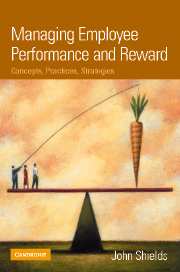Book contents
- Frontmatter
- Contents
- List of figures and tables
- Foreword by John Egan
- Acknowledgements
- Introduction: Setting the scene
- Part 1 The fundamentals
- Part 2 Performance management in action
- Part 3 Base pay and benefits
- 9 Base pay purpose and options
- 10 Base pay structures
- 11 Developing position-based base pay systems
- 12 Developing person-based base pay systems
- 13 Employee benefits
- Case study. Just rewards: Rethinking base pay and benefits at Court, Case & McGowan, commercial law partners
- Part 4 Rewarding employee performance
- Part 5 Fitting it all together
- Model responses to case studies
- References
- Index
13 - Employee benefits
from Part 3 - Base pay and benefits
- Frontmatter
- Contents
- List of figures and tables
- Foreword by John Egan
- Acknowledgements
- Introduction: Setting the scene
- Part 1 The fundamentals
- Part 2 Performance management in action
- Part 3 Base pay and benefits
- 9 Base pay purpose and options
- 10 Base pay structures
- 11 Developing position-based base pay systems
- 12 Developing person-based base pay systems
- 13 Employee benefits
- Case study. Just rewards: Rethinking base pay and benefits at Court, Case & McGowan, commercial law partners
- Part 4 Rewarding employee performance
- Part 5 Fitting it all together
- Model responses to case studies
- References
- Index
Summary
The rise of the concept of ‘total reward management’, which was canvassed in chapter 1, owes a great deal to the growing importance of benefit plans in reward practice. Benefits are among the most variegated, complex and rapidly changing aspects of contemporary reward management practice. Because of their constantly evolving nature, benefits almost defy definition (Lengnick-Hall & Bereman 1994). Known originally as ‘fringe benefits’, today the term ‘employee benefits’ covers both ‘indirect pay’ – that is, financial rewards that do not take the form of direct cash payments, such as employer superannuation and health care fund contributions – and non-financial rewards, ranging from special unpaid leave provisions to the provision of wellness programs and advisory services. Rewards in the form of company shares also fall partly within the scope of benefits programs. As such, benefits are a remarkably heterogeneous phenomenon. Their nature and significance varies considerably from country to country, organisation to organisation, role to role and person to person.
Benefits were once the least glamorous of all aspects of reward management – and were literally referred to as ‘fringe’ reward practices – yet many organisations now consider them to be an important means of gaining a competitive advantage in labour markets where key ‘talent’ is in short supply. As the workforce becomes more diverse and as the level of employee education and reward expectation rises, financial and non-financial benefits are likely to assume an increasingly critical role in the reward management system's ability to attract, retain and motivate high-potential and high-performing employees.
- Type
- Chapter
- Information
- Managing Employee Performance and RewardConcepts, Practices, Strategies, pp. 318 - 339Publisher: Cambridge University PressPrint publication year: 2007
- 1
- Cited by

